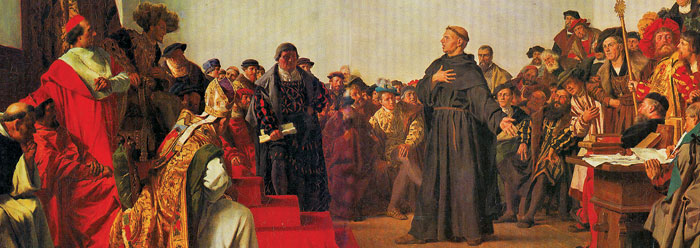Like Dr. Martin Luther’s stand of old, a Missouri Synod Lutheran church took a stand, asserting their religious liberty and conscience rights when they invoked the U.S. Constitution’s First Amendment—not unlike the apostle Paul’s appeal to Caesar.1 Why? Because meaningful religious freedom for churches and parachurch ministries requires gatekeeping autonomy—the power to select religious mission leaders and messengers.
This confrontation also illustrates how the First Amendment is relevant to biblical apologetics, because defending the faith requires vigilant gatekeeping that only a self-governing church body can accomplish. Such autonomy is freedom in action.
As in biblical times, gatekeeping in religious ministry is a serious priority.2 During the 1600s, Puritans sought religious liberty in America, “to elect their own ministers and establish their own modes of worship,” free from governmental jurisdiction or restraint.3 And centuries before that, the English confronted similar conflicts.4
To promote religious liberty, the U.S. Constitution’s First Amendment traces a triangle of intertwined checks and balances: the regulatory rights of Congress, the institutional rights of churches, and the religious liberty rights of individuals.1,3
In 2012, the U.S. Supreme Court applied this intertwined balance to a Christian church-sponsored school in a “first impression” ruling that examined how Equal Employment Opportunity Commission (EEOC) actions conflicted with a Christian ministry’s internal gatekeeping powers—specifically the hiring and firing practices of Hosanna-Tabor Evangelical Lutheran Church and School.3,5
The job termination involved a schoolteacher whose narcolepsy impairment was arguably protected by the Americans with Disabilities Act (ADA), one of Congress’ anti-discrimination/anti-retaliation statutes.5 But does the ADA (or similar employment laws) trump the First Amendment? By no means. The church school’s right to select and manage its own educational ministry personnel prevailed.3,5
So, the EEOC was judicially rebuffed for trying to use Congress-issued powers of “government interference” against “an internal church decision that affects the faith and mission of the church itself”—overreaching the independence of a Lutheran church (and its school) to promote its faith message.6 Thankfully, this rare 9-0 decision recognizes that church/religious organizations have substantial protective exemptions under the First Amendment.
In defending and promoting God’s truth, the apostle Paul appealed to Caesar.1 Likewise, American Christians—especially churches and parachurch ministries—can appeal to the First Amendment. Christians should practice good stewardship of their religious freedoms to resist unjust overreaching by Constitution-dishonoring bureaucrats—because safeguarding religious freedom is part of defending the faith.
References
- Acts 25:11-12, 21; 28:19. This legal perspective builds upon Johnson, J. J. S. 2016. Balancing Church and State. Acts & Facts. 45 (7): 20, and Johnson, J. J. S. 2016. Balancing Church and State, Part 2: Evolutionary Law. Acts & Facts. 45 (9): 20.
- Jude 1:3-4; Philippians 1:7, 17; 3 John 1:7-10; Nehemiah 13:1-8. See also Romans 16:17; 1 Timothy 3:1-13, 4:14, 5:22; 2 Timothy 2:2.
- Hosanna-Tabor Evangelical Lutheran Church & School v. Equal Employment Opportunity Commission, 132 S.Ct. 694 (2012) (per curiam opinion by Chief Justice Roberts), applying the First Amendment’s Religion Clauses to recognize Christian schoolteachers as covered by the “minister” exemption, as an affirmative defense to EEOC’s accusation of illegal discrimination in employment), reversing 597 F.3d 769 (6th Cir. 2010), quoting, 132 S.Ct. at 702, Michael W. McConnell, “The Origins and Historical Understanding of Free Exercise of Religion,” 103 Harvard Law Review. 1409, 1422 (1990).
- “Controversy between church and state over religious offices is hardly new. In 1215, the issue was addressed in the very first clause of Magna Carta. There, King John agreed that ‘the English church shall be free, and shall have its rights undiminished and its liberties unimpaired’.” Quoting 132 S.Ct. at 702, quoting Magna Carta.
- Emphasizing the Lutheran Church—Missouri Synod’s religious mission and message, the U.S. Supreme Court applied the First Amendment to the church school’s right to select and manage its own religious-message-promoting personnel. “Requiring a church to accept or retain an unwanted minister, or punishing a church for failing to do so, intrudes upon more than a mere employment decision. Such action interferes with the internal governance of the church, depriving the church of control over the selection of those who will personify its beliefs. By imposing an unwanted minister, the state infringes the Free Exercise Clause, which protects a religious group’s right to shape its own faith and mission through its appointments.” Quoting Hosanna-Tabor Evangelical Lutheran v. EEOC, 132 S.Ct. at 705-706.
- “By requiring the Church to accept a minister [whom] it did not want, such an order would have plainly violated the Church’s freedom under the Religion Clauses to select its own ministers.” Quoting Hosanna-Tabor Evangelical Lutheran v. EEOC, 132 S.Ct. at 709. This dovetails with an earlier labor law ruling in Holy Trinity Church v. United States. 143 U.S. 457, 12 S.Ct. 511 (1892), by Justice David Josiah Brewer, a Smyrna native.
* Dr. Johnson is Associate Professor of Apologetics and Chief Academic Officer at the Institute for Creation Research.














